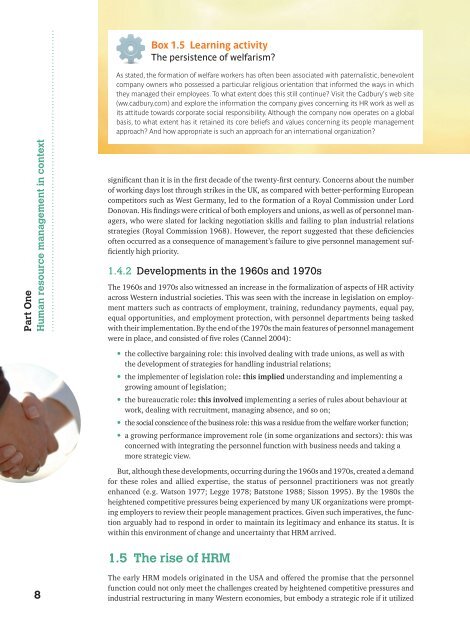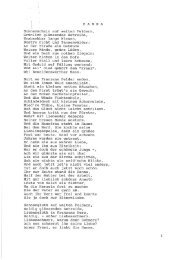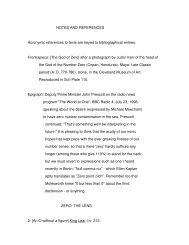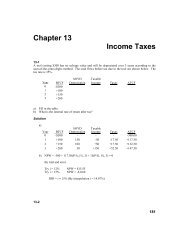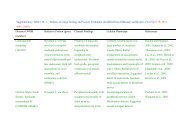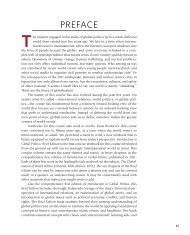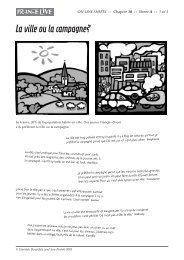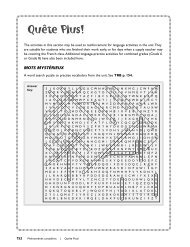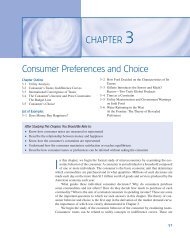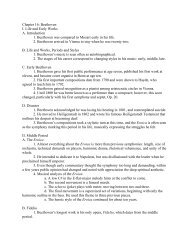Human Resource Management in Context
Human Resource Management in Context
Human Resource Management in Context
You also want an ePaper? Increase the reach of your titles
YUMPU automatically turns print PDFs into web optimized ePapers that Google loves.
Part One<br />
<strong>Human</strong> resource management <strong>in</strong> context<br />
8<br />
Box 1.5 Learn<strong>in</strong>g activity<br />
The persistence of welfarism?<br />
As stated, the formation of welfare workers has often been associated with paternalistic, benevolent<br />
company owners who possessed a particular religious orientation that <strong>in</strong>formed the ways <strong>in</strong> which<br />
they managed their employees. To what extent does this still cont<strong>in</strong>ue? Visit the Cadbury’s web site<br />
(ww.cadbury.com) and explore the <strong>in</strong>formation the company gives concern<strong>in</strong>g its HR work as well as<br />
its attitude towards corporate social responsibility. Although the company now operates on a global<br />
basis, to what extent has it reta<strong>in</strong>ed its core beliefs and values concern<strong>in</strong>g its people management<br />
approach? And how appropriate is such an approach for an <strong>in</strong>ternational organization?<br />
signifi cant than it is <strong>in</strong> the fi rst decade of the twenty-fi rst century. Concerns about the number<br />
of work<strong>in</strong>g days lost through strikes <strong>in</strong> the UK, as compared with better-perform<strong>in</strong>g European<br />
competitors such as West Germany, led to the formation of a Royal Commission under Lord<br />
Donovan. His fi nd<strong>in</strong>gs were critical of both employers and unions, as well as of personnel managers,<br />
who were slated for lack<strong>in</strong>g negotiation skills and fail<strong>in</strong>g to plan <strong>in</strong>dustrial relations<br />
strategies (Royal Commission 1968). However, the report suggested that these defi ciencies<br />
often occurred as a consequence of management’s failure to give personnel management suffi<br />
ciently high priority.<br />
1.4.2 Developments <strong>in</strong> the 1960s and 1970s<br />
The 1960s and 1970s also witnessed an <strong>in</strong>crease <strong>in</strong> the formalization of aspects of HR activity<br />
across Western <strong>in</strong>dustrial societies. This was seen with the <strong>in</strong>crease <strong>in</strong> legislation on employment<br />
matters such as contracts of employment, tra<strong>in</strong><strong>in</strong>g, redundancy payments, equal pay,<br />
equal opportunities, and employment protection, with personnel departments be<strong>in</strong>g tasked<br />
with their implementation. By the end of the 1970s the ma<strong>in</strong> features of personnel management<br />
were <strong>in</strong> place, and consisted of fi ve roles (Cannel 2004):<br />
• the collective barga<strong>in</strong><strong>in</strong>g role: this <strong>in</strong>volved deal<strong>in</strong>g with trade unions, as well as with<br />
the development of strategies for handl<strong>in</strong>g <strong>in</strong>dustrial relations;<br />
• the implementer of legislation role:<br />
this implied understand<strong>in</strong>g and implement<strong>in</strong>g a<br />
grow<strong>in</strong>g amount of legislation;<br />
• the bureaucratic role:<br />
this <strong>in</strong>volved implement<strong>in</strong>g a series of rules about behaviour at<br />
work, deal<strong>in</strong>g with recruitment, manag<strong>in</strong>g absence, and so on;<br />
• the social conscience of the bus<strong>in</strong>ess role: this was a residue from the welfare worker function;<br />
• a grow<strong>in</strong>g performance improvement role (<strong>in</strong> some organizations and sectors): this was<br />
concerned with <strong>in</strong>tegrat<strong>in</strong>g the personnel function with bus<strong>in</strong>ess needs and tak<strong>in</strong>g a<br />
more strategic view.<br />
But, although these developments, occurr<strong>in</strong>g dur<strong>in</strong>g the 1960s and 1970s, created a demand<br />
for these roles and allied expertise, the status of personnel practitioners was not greatly<br />
enhanced (e.g. Watson 1977; Legge 1978; Batstone 1988; Sisson 1995). By the 1980s the<br />
heightened competitive pressures be<strong>in</strong>g experienced by many UK organizations were prompt<strong>in</strong>g<br />
employers to review their people management practices. Given such imperatives, the function<br />
arguably had to respond <strong>in</strong> order to ma<strong>in</strong>ta<strong>in</strong> its legitimacy and enhance its status. It is<br />
with<strong>in</strong> this environment of change and uncerta<strong>in</strong>ty that HRM arrived.<br />
1.5 The rise of HRM<br />
The early HRM models orig<strong>in</strong>ated <strong>in</strong> the USA and off ered the promise that the personnel<br />
function could not only meet the challenges created by heightened competitive pressures and<br />
<strong>in</strong>dustrial restructur<strong>in</strong>g <strong>in</strong> many Western economies, but embody a strategic role if it utilized


